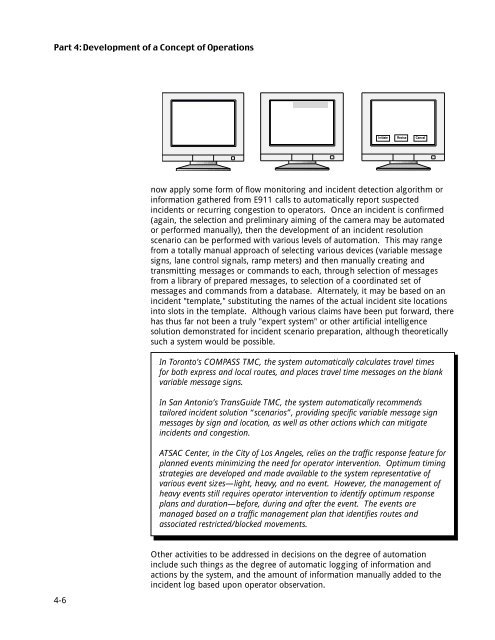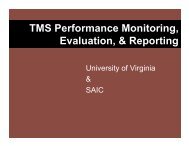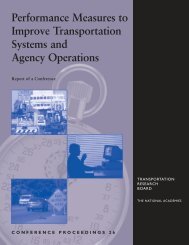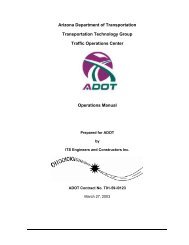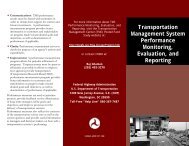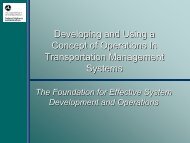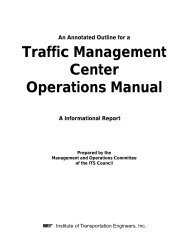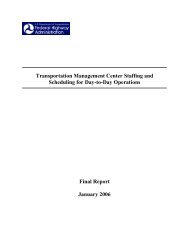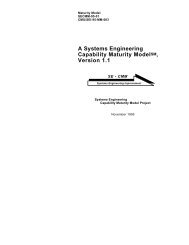Initiate Revise Cancelnow apply some form <strong>of</strong> flow monitoring and incident detection algorithm orinformation gathered from E911 calls to automatically report suspectedincidents or recurring congestion to operators. Once an incident is confirmed(again, the selection and preliminary aiming <strong>of</strong> the camera may be automatedor performed manually), then the development <strong>of</strong> an incident resolutionscenario can be performed with various levels <strong>of</strong> automation. This may rangefrom a totally manual approach <strong>of</strong> selecting various devices (variable messagesigns, lane control signals, ramp meters) and then manually creating andtransmitting messages or commands to each, through selection <strong>of</strong> messagesfrom a library <strong>of</strong> prepared messages, to selection <strong>of</strong> a coordinated set <strong>of</strong>messages and commands from a database. Alternately, it may be based on anincident "template," substituting the names <strong>of</strong> the actual incident site locationsinto slots in the template. Although various claims have been put forward, therehas thus far not been a truly "expert system" or other artificial intelligencesolution demonstrated for incident scenario preparation, although theoreticallysuch a system would be possible.In Toronto’s COMPASS TMC, the system automatically calculates travel timesfor both express and local routes, and places travel time messages on the blankvariable message signs.In San Antonio’s TransGuide TMC, the system automatically recommendstailored incident solution “scenarios”, providing specific variable message signmessages by sign and location, as well as other actions which can mitigateincidents and congestion.ATSAC <strong>Center</strong>, in the City <strong>of</strong> Los Angeles, relies on the traffic response feature forplanned events minimizing the need for operator intervention. Optimum timingstrategies are developed and made available to the system representative <strong>of</strong>various event sizes—light, heavy, and no event. However, the management <strong>of</strong>heavy events still requires operator intervention to identify optimum responseplans and duration—before, during and after the event. The events aremanaged based on a traffic management plan that identifies routes andassociated restricted/blocked movements.Other activities to be addressed in decisions on the degree <strong>of</strong> automationinclude such things as the degree <strong>of</strong> automatic logging <strong>of</strong> information andactions by the system, and the amount <strong>of</strong> information manually added to theincident log based upon operator observation.4-6
Main> MBCommand-Based InterfaceMenu-Based InterfaceMESSAGE BOARD UTILITY PROGRAMEnter desired message.Accident at Bradley Road (Exit 7)Expect 1-Hour DelayDetour: Exit 6 to Abrams Road WestMORE?> NMESSAGE BOARD UTILITY PROGRAMEnter variable message sign number(s)4N95, 5N95, 6N95YOU HAVE ENTERED THE MESSAGE“Accident at Bradley Road (Exit 7)Expect 1-Hour DelayDetour: Exit 6 to Abrams Road West”FOR DISPLAY ON VARIABLE SIGN NUMBERS4N95, 5N95, 6N95IS THIS CORRECT?EXITING THE MESSAGE BOARD UTILITY PROGRAMUse the display message (DM) command to implementMAIN> send messageHuman Factors Handbook for Advanced Traffic <strong>Management</strong> <strong>Center</strong> Design, FHWA, 1999Human Factors <strong>of</strong> User InterfacesThe human factors decisions reflected in the concept <strong>of</strong> operations will havesignificant impact upon the facility, the staffing, and the systems components <strong>of</strong> theTMC. Key decisions, such as the use <strong>of</strong> voice recognition technology, placement <strong>of</strong>video in windows on the workstation, or use <strong>of</strong> handsets or headsets for radio andtelephone communications can have major impacts on the effectiveness <strong>of</strong> theworking environment, and on the cost and time to implement the system. Classicdecisions in computer user interfaces, such as the extent <strong>of</strong> use <strong>of</strong> pull-down menus,pop-up windows, and command line interfaces will be required, <strong>of</strong>ten on asubfunction-by-subfunction basis. Considerations such as the level <strong>of</strong> experienceand knowledge <strong>of</strong> the operations personnel and the degree <strong>of</strong> training provided tothem must be considered in order for the human factors decisions to be consistentwith the remainder <strong>of</strong> the concept <strong>of</strong> operations. More subtle decisions, such as theuse <strong>of</strong> noise reduction technologies in the control room, lighting, the color patterns<strong>of</strong> computer screens, the order <strong>of</strong> progression between fields on a screen, thebreakdown <strong>of</strong> mandatory and optional fields on data entry screens, and the number<strong>of</strong> screen levels necessary to reach <strong>of</strong>ten-used functions, can become critical to thepace <strong>of</strong> decision making and implementation, particularly in crisis operation.In the Washington, D.C. WMATA train control system, the screen presents animage which visually depicts the rail line under the operator’s control. Majoritems such as stations are represented along the tracks. Each item is an icon,further detail for which can be obtained by clicking on the item. At the lowestlevel <strong>of</strong> detail, clicking on an item provides textual information about the item,including both static and real time status.4-7
- Page 1 and 2: Transportation ManagementCenterConc
- Page 3 and 4: Executive SummaryPart 1 Introductio
- Page 5 and 6: Agencies responsible for managing l
- Page 7 and 8: Focus of theDocumentPurposeThe purp
- Page 9 and 10: • The Systems• Operational Faci
- Page 11 and 12: WhatChallengesDo TMC’sFace?The mo
- Page 13 and 14: The concept of operation should doc
- Page 15 and 16: This section defines the types of t
- Page 17 and 18: Following notification, incidents a
- Page 19 and 20: Many fine examples of transit manag
- Page 21 and 22: System Control and DataAcquisitionS
- Page 23 and 24: The Contextof aConcept ofOperations
- Page 25: Where Does the Concept of Operation
- Page 28 and 29: Other Regional Impacts to Operation
- Page 31 and 32: An important element of jurisdictio
- Page 33 and 34: IntroductionThe concept of operatio
- Page 35 and 36: The concept of operation should als
- Page 37: At some point in the process, the r
- Page 41: Western MDTraffic OperationsCenterG
- Page 44 and 45: Field Device Examples• The TMC in
- Page 46 and 47: OperationalFacilityNeedsThere are m
- Page 48 and 49: Needs or Desires IdentifiedThe conc
- Page 50 and 51: The City of Los Angeles ATSAC Cente
- Page 52 and 53: At ATSAC, new hardware, devices, an
- Page 54 and 55: Less pleasant, although sometimes i
- Page 56 and 57: Deciding Whether/How to Share Contr
- Page 58 and 59: Caltrans and the California Highway
- Page 60 and 61: een compiled during the shift. Such
- Page 62 and 63: High level measures may include the
- Page 64 and 65: Example OrganizationDOT District En
- Page 66 and 67: Although ITE has established a reco
- Page 68 and 69: Los Angeles’ ATSAC Traffic Operat
- Page 70 and 71: Staff Cross-TrainingCross-training,
- Page 72 and 73: are needed will conclude by identif
- Page 74 and 75: How Process Improvements Are MadeSi
- Page 76 and 77: The concept of operations deals wit
- Page 78 and 79: This communication can take place i
- Page 80 and 81: The potential cost of configuration
- Page 82 and 83: • The beginning of a task- Change
- Page 84 and 85: need to address, if possible, the c
- Page 86 and 87: Process Improvement Maintenance, as
- Page 88 and 89:
The training material is typically
- Page 90 and 91:
identifying the core documents (inc
- Page 92 and 93:
OperationalProcurementandContractin
- Page 94 and 95:
communications, heating/ventilation
- Page 96 and 97:
• Consulting The TMC may find tha
- Page 98 and 99:
• Standard agency payment process
- Page 100 and 101:
Human Factors GuidelinesThe Georgia
- Page 102 and 103:
How Can IFind OutMore AboutConcepts
- Page 104 and 105:
References1 Booz·Allen & Hamilton
- Page 106 and 107:
25 Institute of Transportation Engi
- Page 108 and 109:
For further information, contact:Fe
- Page 110:
INTELLIGENT TRANSPORTATION SYSTEMSU


